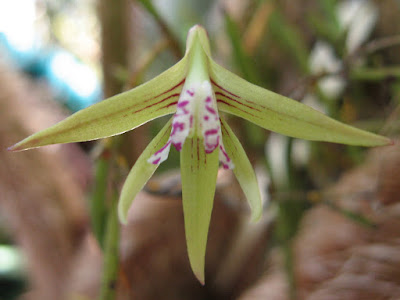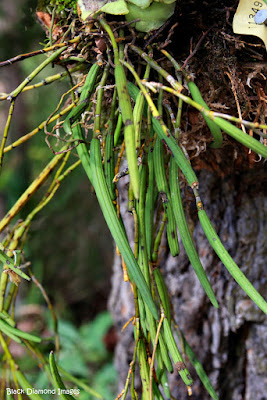Dockrillia schoenina is native to Eastern Australia. Their natural habitat stretches from Newcastle, New South Wales to the Burdekin River in the north-east of Queensland. They usually grow on trees and rocks in rain forests or rare forests with high humidity...
Dockrillia schoenina also called as The Needle-Shaped Dockrillia, Common Pencil Dockrillia, Callista beckleri, Dendrobium beckleri, Dendrobium mortii, Dendrobium schoeninum, Dendrobium striolatum, Dendrobium striolatum var beckleri, Dockrillia beckleri, is a species of the genus Dockrillia. This species was described by Mark Alwin Clements & David Lloyd Jones in 1996.
IDENTIFY DOCKRILLIA SCHOENINA
Dockrillia schoenina is native to Eastern Australia. Their natural habitat stretches from Newcastle, New South Wales to the Burdekin River in the north-east of Queensland. They usually grow on trees and rocks in rain forests or rare forests with high humidity, at the altitude from sea level to approx. 600 m.
It is a medium sized epiphyte or lithophyte, which reaching 90 cm in height, with superposed or branching, many noded, yellowish, 90 cm long stems carrying a single, apical, upright or spreading, terete or obtusely 4 angled, acute, deeply sulcate, 2-16 cm long leaf.
The Needle-Shaped Dockrillia blooms in the late winter and early spring on a short, one to few flowered inflorescence that arises from the nodes at the tips of the branches and giving rise to fragrant, non-resupinate flowers. The flowers are 2.5 - 5.5 cm in diameter. The flakes of both whorls may be creamy, white, yellow, pale green or pink with dark purple stripes on the underside. The white lip may be decorated purple at the edges. The petals of both whorls are directed downwards and the lip is up. It is a three-part with a pointed, curved tip. The side edges of the lip are wavy. The lip has 3 lines wavy at the apex.
DOCKRILLIA SCHOENINA CARE AND CULTURE
Cultural information should only be used as a guide, and should be to be adapted to suit you. Your physical location; where you grow your plants, how much time you have to devote to their care, and many other factors, will need to be taken into account. Only then can you decide on the cultural methods that best suit you and your plants.
Light:
Dockrillia schoenina needs a light level of 30000 - 40000 lux. The level of light should be as high as possible, as the plant can bear without burning the leaves. 40-50% of shading is recommended for cultivation, but a high level of light is necessary to initiate flowering.
Temperature:
It is a plant with moderate thermal requirements. In summer, the average daytime temperature is 25-27 ° C, at 17-18 ° C at night, which gives a daily difference of 9-10 ° C. The average temperature of the winter day is 17-22 ° C, and the night 7-10 ° C, which gives a daily difference of 9-10 ° C.
Humidity:
The Needle-Shaped Dockrillia needs the humidity of 60-65% throughout the year.
Substrate, growing media and repotting:
Because of their hanging habit, Dockrillia schoenina should be mounted on cork, tree fern or other uneven bark rootstocks. Although the shoots are quite large, the roots grow only at the base of the shoot and the plant works well on a small pad, even on a stick with high humidity ensured and must be watered at least once a day during the summer. When growing in a pot, the pot should be small and filled with good and quickly permeable substrate. Plastic pots are less beneficial. Repotting is best done immediately after flowering.
Watering:
Precipitation is moderate to very abundant in summer and autumn. These plants should be kept in constant humidity during the growing season, but in the autumn the amount of water should be gradually reduced. Some breeders suggest that small plants are healthier if allowed to lightly dry between waterings.
Fertilizer:
These plants should be fertilized every week 1/4-1/2 of the recommended dose of fertilizer for orchids. A fertilizer with a high nitrogen content is beneficial from spring to mid-summer, and a fertilizer richer in phosphorus should be used in late summer and autumn.
Rest period:
In winter, watering and fertilizing should be significantly reduced, Dockrillia schoenina should be allowed to lightly dry between waterings, but they can not be completely dry for a long period of time.















COMMENTS